Responses
Natalie Adams (Information Services Manager, Churchill Archives Centre) – hereinafter (NA)
Ian Anderson (Director of Museum Studies, HATII, University of Glasgow) – hereinafter (IA)
Chris Bird (Senior Legal Counsel at the Wellcome Trust) – hereinafter (CB)
Susan Corrigall (Copyright Officer at the National Records of Scotland) – hereinafter (SC)
Ronan Deazley (Professor of Copyright Law, University of Glasgow) – hereinafter (RD)
Judith Etherton (Freelance Archivist) – hereinafter (JE)
Christy Henshaw (Digitisation Programme Manager, Wellcome Library) – hereinafter (CHen)
Caroline Herbert (former Content and Metadata Officer, Wellcome Library) – hereinafter (CHer)
David Mander (Vice-Chair, Board of the Archives and Records Association, UK) – hereinafter (DM)
Craig Alexander Moore (Records Manager, the Bar Council) – hereinafter(CAM)
Tim Padfield (International Council on Archives) – hereinafter (TP)
Lesley Richmond (University Archivist and Deputy Director, University of Glasgow Library) – hereinafter (LR)
Ellie Robinson (Archivist, LSE) – hereinafter (ER)
Victoria Stobo (Research Assistant and Postgraduate Researcher, CREATe, University of Glasgow) – hereinafter (VS)
Cathy Williams (Head of Collections Knowledge, TNA) – hereinafter (CW)
DM: Can I now ask our first session panel, Christy, Caroline and Lesley to resume the stage and we can then open up for questions. The floor is yours and roving mics are coming round. Again, please say who you are and your institution before asking the question.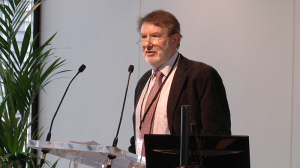
CW: Cathy Williams from the National Archives. I've got a couple of comments to make. Firstly, the issue there about avoiding commercialisation: some archives need to think about commercialising what they hold, simply to sustain themselves. For some archives, their model of sustainability in the future will include commercial use of what they hold, so I think that's something to consider.
The other issue this morning Lesley was talking about, yes, archives are the result of human activity but for many archives even in what might seem quite mundane collections you could trip over material that was produced for commercial use. Don't forget, there are many film archives, there are photographic archives, the National Archives, even when we digitised for a London 2012 project, even hidden among Crown copyright material from government, are cuttings from newspapers. It took us a very long time to trace owners of old sporting magazines and so on, and that's hiding in amongst official public records. It is complex and I don't want to over complicate things. One of the things we're now embarking on is a programme called Archiving the Arts and we would welcome working with CREATe on aspects of artistic archives, where some of the material is about an artist’s bread and butter and whereas we might want to hold it and make it publicly accessible, but when we're looking at deposit agreements, copyright agreements, it gets very complicated.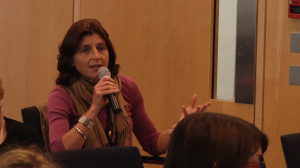
DM: Thank you Cathy, who wants to comment or respond from the panel.
CHen: I'll just comment on the idea that people amass a lot of different things over their life, it gets into their archive, and some of that would have been newspaper clippings, magazines. You do need to know what's in your archive before you make any kind of blanket assessment about what kind of copyright clearance you're going to do, because you've got assess those things as well. From our point of view, we don't really think that a stray newspaper clipping is a very high risk at all. An entire magazine is more of a high risk. We may not clear it, we may not even digitise it, because you can probably get it somewhere else. So yeah, absolutely it's not just all things people have written on napkins.
DM: Yes, Judith first and then Tim.
JE: Judith Etherton, I'm a freelance archivist and my question is about the commercial aspect as well, it follows on from something that Lesley said at the end of her talk about how your Codebreakers project was non-commercial and this was the copyright clearance you did. But now the images are out on the web, people will want to use them, probably, commercially and how are you going to deal with this going forward. I would like to actually have a little bit more discussion on this aspect.
CHen: It hasn't happened yet, but we would have to look at each request individually and if they were asking for commercial use of something where we don't know the contact details, because it's not someone we've traced before, we would ask them to trace the copyright holder and get permission to use it. We don't have a service that provides that for people because they want to use an image. We don't have the resources to go out and trace the copyright for them, so if they really want to use it for commercial purposes, they've got to do that, then they can tell us that they've got that permission or they can show us that they've got that permission.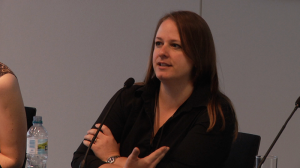
There might be things that turn out to be out of copyright, but we never had a chance to really look at it when we were doing a mass digitisation project. If somebody says, “This one image, I'd really like,” we look at it and that one happens to be out of copyright, you never know. You've got to take it on a case by case basis. If we did have the details of the people, and this does come back to Lesley's point about keeping things up to date, and we felt that it was something we wanted to do, we could potentially contact those people for them on their behalf and see if they would be happy. Commercial use is a bit grey sometimes. It could be something that's a really valuable use, and it could be very academic but it's also commercial, and people might be perfectly happy about that. But at the moment we don't have contributor agreements with people where we pay royalties. We don't have any of that in place for this content.
DH: Does any other panel member want to come in?
CHer: I was only going to say, I think in effect what Christy's describing would be much the same for any archives, with users sitting in the reading room, looking through a file and thinking, I want to put this letter in my next book. In some ways the fact that the material's online wouldn't really affect that part of how the library would respond to a request.
DM: Thanks, Tim you wanted to come in?
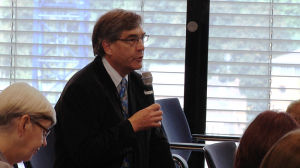 TP: Yes, Tim Padfield. I'm retired but I'm down on the programme as representing the International Council on Archives. I have one comment and one question. The comment is, I recognise the need to accept risk but personally I would urge archivists to make sure that they get approval from their senior management, rather than take any risk themselves. Always get senior management agreement so that they take the risk. My question is one about the rights owners. The assumption seems to be that you do all this diligent research and you come across a single rights owner. My experience with wills is that most people when they leave a will do not mention copyright at all, and so copyright would be among the residuary beneficiaries’ benefits, and there might well be several of them. If I leave everything I own to all my children, I might have four children and that means there will be four owners that you have to trace. I think the assumption that there is a single owner, even through several generations, is probably making it sound even easier than it really is.
TP: Yes, Tim Padfield. I'm retired but I'm down on the programme as representing the International Council on Archives. I have one comment and one question. The comment is, I recognise the need to accept risk but personally I would urge archivists to make sure that they get approval from their senior management, rather than take any risk themselves. Always get senior management agreement so that they take the risk. My question is one about the rights owners. The assumption seems to be that you do all this diligent research and you come across a single rights owner. My experience with wills is that most people when they leave a will do not mention copyright at all, and so copyright would be among the residuary beneficiaries’ benefits, and there might well be several of them. If I leave everything I own to all my children, I might have four children and that means there will be four owners that you have to trace. I think the assumption that there is a single owner, even through several generations, is probably making it sound even easier than it really is.
DM: Who wants to pick that one up?
LR: Well, I would agree. One of our three collections that we were digitising, there were two marriages with five children, and both wives were still alive. I was going to ask people, do you think you have the copyright? Were you still on speaking terms with your first husband? It was extremely difficult and Glasgow University Archives could not crack that, we tried and we tried and we tried. It was Wellcome who managed to work out where the first wife or the second wife was living. It is split between all the family, but what Victoria said earlier has now become very good, because we now have different members of the family very enthusiastic about Codebreakers. They've been to every event that Wellcome's had about Codebreakers, different members of them, but I don't know if they can all get into the same room at the same time and not have a fight.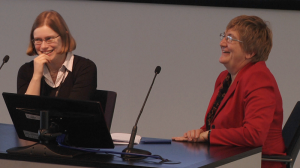
CHer: Can I just come back? Yes, I agree we were making assumptions about copyright, next of kin and residual estates, so yes I suppose there is an argument that we should have checked every will and gone through all the family. In practice, we found that because this was a limited list and we were looking at people with high public profiles, generally if we did contact one of the children, there was someone who was more used to speaking on behalf of the family to answer such requests. It was only in some cases where they would bring other siblings into the loop, and say, “Check with my brother or my sister as well.” If we tracked one descendant, we were relying on them to do the decent thing and share with us if there were others who should be involved, which I think generally they did.
NA: I'm Natalie Adams from Churchill Archive Centre and what I wanted to say is more of a comment. I've spent a long time working in the publication of the Churchill papers which has been a commercial project, so it's different from the Wellcome project in that key sense, and we also had to be more comprehensive in our clearance. But what we found at the end shook down to a very similar situation that the Wellcome have found. Most of the people said yes, a few more of them than the Wellcome had asked for money, but that's completely fair enough as it was a commercial project. But what we also found was this feel good thing where people were amazed, “My grandfather wrote to Churchill, can I see it? You want to publish it? How brilliant, yes.” Don't necessarily think that because it's a commercial project that's going to completely change the landscape that the Wellcome have found. because I don't think it necessarily does. Also, I wanted to echo the very difficult decisions about which rightsholders to contact, we did quite a lot of clearing all the people we thought it might be, rather than trying to decide who we thought it was.
SC: Susan Corrigall again. I was intrigued by Victoria's estimate of the quantity of orphan works in archival collections. You estimated between twenty one and twenty five percent of our archival collections would be orphan works. It strikes me that that's rather optimistic thinking about collections in my own institution, I would completely flip that percentage it would be much more like eighty percent, ninety percent. But I can see that in other institutions, other collections it would be quite different. I think that would be a highly variable figure depending on the nature of the institution and the nature of the collections held.
VS: Absolutely, I would agree. That figure's based on the JISC In From the Cold study of orphan works and that was a Europe-wide study. I think that's one of the problems with the evidence that is available, it's conducted at a very high level so when you do try to apply it in specific instances, it doesn't appear to match up or it doesn't seem quite as relevant. That's an area where more research has to happen and it could happen in Britain specifically, not just at a Europe-wide level. I would agree that it does depend on the collection and the institution in question.
DM: Craig next, at the back.
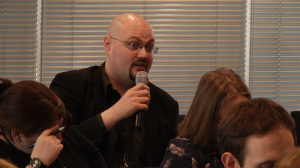 CAM: Craig Alexander Moore of the Bar Council. I'm interested in the role of lawyers in risk taking, because as I'm sure many of you are aware, lawyers are some of the most risk averse creatures on the planet. There have been many compliance issues where I’ve put together the presentation, I’ve vigorously argued at Board level, everyone nods and says yes that all sounds very good, let's just run it past legal and I've never heard about it again. If a solicitor is going to act as the final arbitrator on risk, how can we as practitioners address that?
CAM: Craig Alexander Moore of the Bar Council. I'm interested in the role of lawyers in risk taking, because as I'm sure many of you are aware, lawyers are some of the most risk averse creatures on the planet. There have been many compliance issues where I’ve put together the presentation, I’ve vigorously argued at Board level, everyone nods and says yes that all sounds very good, let's just run it past legal and I've never heard about it again. If a solicitor is going to act as the final arbitrator on risk, how can we as practitioners address that?
DM: Who wants to tackle that one?
CB: Chris Bird, Senior Legal Counsel at the Wellcome. I’m not sure what I can say about this, but one thing I would say is we have various levels of lawyer in this organisation, I have a boss whose job title is the General Counsel of the organisation, and we face some issues getting it through the legal hurdles and we have lots of debates. As I said to some people in the coffee break, it quite often ended up with me banging the table and saying, “Look, we are doing this, get comfortable, let me help you get comfortable but we are going to do it.” And if we're not going to do it, then we really need to think about how we act as business partners to the organisation. It does need one of the lawyers at least to be quite integrated into what the business wants to achieve, and to have quite a developed view for themselves of what risk really looks like, and in that case it was me.
DM: Can I endorse that. I think there is a strong risk in a large organisation of the legal team having insufficient expertise and you can then present a case that can either then be met with that awful thing, a long silence, or even worse, wrong information coming back to you. With due respect to my learned friends, they're not always the fountain of information that you feel they ought to be. Key communication is needed here, otherwise what you get is a rushed judgement which won't help you, and I'm not going to name the organisation concerned, but can actually be plain wrong and circulated and unhelpful if this is a partnership project. Any more questions?
ER: I’m Ellie Robinson from the London School of Economics. I have two questions, if that's all right. Just quickly for Christy, when you were managing the digitisation for Codebreakers, was the digitisation run concurrently with the copyright clearance work, or did you wait for permission until you started digitisation?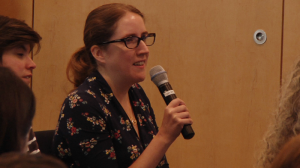
CHen: It depends on the project, but with archives we started first and then we sought copyright clearance. We weren't putting it online at the time, we were just digitising. We didn't put anything online until the copyright clearance procedure had gone through, but that ended up working out quite well in a practical sense because so many people did ask for copies and we had them for the most part, once we established how exactly we were going to do it. Now when we do new collections we start copyright clearance as soon as we know what collection we're doing.
ER: And for the metadata for the digitised objects, did you go back and update the rights information for those?
CHen: Yes, so there's various different ways we've updated the rights, we've also assigned licenses to material. If we need to, we can assign different types of licences to material. That came in with the books where copyright holders had a lot of different choices of access, whereas with the archives we really just wanted attribution non-commercial access. For the most part we didn't have to do too much of that. If somebody said they wanted to be credited in a certain way, we can put that back in the catalogue record but that does add on extra effort, it’s just another thing we couldn’t do if we were trying to clear every single copyright holder.
ER: And if I can ask Victoria, with the risk criteria that you've been examining, I was wondering if the size of the institution has any impact on that? Obviously the Wellcome is a very high profile, well known institution with a large audience, and I was wondering if smaller institutions with a smaller audience and smaller number of people who would ever potentially see the material that you're putting online, whether that has an impact on the level of risk?
VS: Yes, I think it will. The risk criteria that the Wellcome used, has been the only risk criteria that I've looked at. Over the course of my PhD I would like to get in touch with smaller institutions that are making material available online and look at what kind of risk analysis they do before they do that, so I don't really have very much information on that at the moment, but hopefully I will be able to generate that information. I think it will have a definite effect on their risk analysis.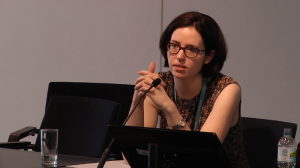
IA: Ian Anderson, University of Glasgow. Question for Lesley, you mentioned how glad you were that Wellcome was accepting the liability in terms of this project. I'm just wondering whether having had the experience of it, you would be more willing to accept liability? Or is it preferable, particularly in collaborative digitisation projects, for one of the partners to accept liability on behalf of everybody, perhaps the partner with the greatest appetite for risk?
LR: Part of being grateful for Wellcome being the publisher, so therefore taking on the liability, was really because this project was going to be such a high profile project, and we were dealing with twentieth century material where there's definitely going to be higher risk of copyright holders perhaps wanting the material taken down etc. I do have a large appetite for risk generally, although when Victoria was talking about organisations that look at their lower risk material first, we're probably that at the same time. I've got a large appetite but I’m still cautious. We just have such a lot of material that is out of copyright that we can digitise so, do that first, but at the same time take part in projects like this, where you're learning how to do the recent material that's more risky. Again, it's the nature of the collaborative partnership that you're in, but if you're in collaboration with a national organisation and you can persuade them that they'll take on the burden of doing the due diligence over the copyright holders, then there is an advantage for one taking the lead overall on the copyright, and actually being the publishers. But it really comes down to what that body's putting into the whole project, and Wellcome were taking the lead on so much and we were just the partners that joined in. If I was going to go into partnership with other Scottish universities, for instance, I don't see that one of us probably wouldn't take that lead, unless we'd got money from a funding council, so it's where your funding is coming from.
CHen: Do you mind if I just add to that, because we were taking responsibility for the risk of making material available online through our own website, but for example Coldspring Harbour Laboratory have also made their Watson and Brenner material available on their own website. If they didn't think that the copyright clearance procedure was good enough, they would have had to go and do more themselves in order to fulfil their own appetite for risk for their own website, we wouldn’t have covered them. We weren't taking the risk for them doing stuff with their images, if that makes sense. It sounded a little bit like you might have thought that we were taking on all the publishing, all the risk, that isn't necessarily the case.
LR: It seems completely nonsensical to have this material available on two websites. It may lead researchers to think there's more material out there, so we're not publishing the material that we've digitised online ourselves. We've taken part in the Codebreakers project, so I think that would also make a difference too. You could see projects where it wasn't being published in one place, and each institution was publishing themselves.
DM: I'm going to exercise chair's privilege and squeeze a question in of my own here. Victoria, but for other panel members as well, you talked about the very high costs in staff time of identifying risk. Do you think you, or other panel members, can come up with formulae that will help people who are putting projects together for grant assessment, to say here is a methodology for you to cost this out and go to the funder?
LR: Yes, I think it will be possible.
DM: Because that will be really useful actually, something that quantifies, not says this is the flat figure, but here are the stages, here are the things you need to think about in order to arrive at your costs with all the risks that we're all very well aware of. That would be very helpful. Thank you for a very lively question session.
To leave feedback on the discussion within this Q&A session, click here.
